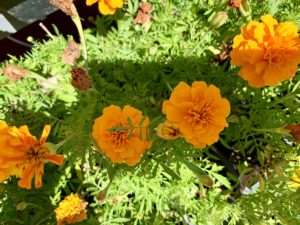Hello, fellow lovers of all things green. Last week, I shared A Butterfly Garden of Growth and added suggestions for annual lovelies to enhance the environment and provide food for our beloved butterflies. Marigolds are one of them, a plant I once was weary of. Learning the magnificent legend of marigolds, their beauty, and their benefits to hummingbirds and butterflies renewed my admiration of “Mary’s Gold.” I hope it will do the same for you.

Races Farm, Blairstown NJ
“Mary’s Gold”
A display of marigolds caught my eye while shopping for annuals for a client a while back. I hadn’t planted them for years, having grown them incessantly as a kid; I fondly remember my garden —primarily marigolds grown from seed. “Mary’s Gold,” I called them. I’d wear out a path around the rectangular plot, rushing to weed it in time for judgment day (for 4-H, that is.) I’m giggling as my enthusiasm for planting a garden still by far overshadows the task of weeding — poor, neglected gardens.
I shared my long hiatus from marigolds with Holly of Blairstown, who worked at our local Races Farm then. She told the story of their significance in the Day of the Dead, known as Día de Muertos, celebrated for centuries in Mexico—a joyful commemoration from October 31st to November 2nd flooded with the glorious vibrant yellow, gold, and orange hues of marigolds. Loved ones who passed away are believed to be soulfully present in the celebration.
“During the Day of the Dead, if you don’t remember your loved one, it’s as if they died twice,” Holly said.
The Legend of Marigolds
Stemming from a long-ago legend, Marigolds became the theme flower for the Day of the Dead. Two Aztec children who grew up together loved to explore a mountaintop nearby. While there, they presented flowers to the Sun God, who in return would “smile from the sky with warm rays,” writes Inside-Mexico.com. As they grew into adults, they fell in love and swore to each other that their love would never end.
Huitzilin goes off to war and dies in battle. Devastated, Xóchitl returns to the mountaintop and prays to the Sun God to bring them back together. A ray of sunshine kisses her cheek and transforms her into a flower as bright as the sun. Then, a hummingbird suddenly appears and touches the flower. Her twenty petals are instantly open. As the story goes, their love will remain if marigold flowers and hummingbirds stay on earth.
Learning about the legend renewed my admiration. Since then, I have planted a tray of Aztec Marigolds each season and celebrate every hummingbird’s arrival.
The Beauty and Benefits of Marigolds
Marigolds are deer-resistant and also attract butterflies. They’re often companion plants in vegetable gardens to control insects and nematodes. And are used as a spice in cooking. Golden flowers are fed to chickens to yellow up their yolks.

French Marigolds are shorter and broader than the African Marigolds.
French Marigolds (Tagetes patula) are shorter and broader than the African Marigolds (T. erecta), also known as Aztec Marigolds—named after the Aztecs. They used them for ceremonial and medicinal purposes long ago. Besides the iconic golden yellow, there are creamy-white and orange African Marigolds. Some varieties have large pom-poms of happy face blooms that sit above dark green foliage and grow three feet tall. Please don’t line them up like soldiers, though, as some folks do, because smiles look better in groups, just like on people.

Antigua Gold African Marigolds (Tagetes-erecta)
Signet (single) Marigold blooms (T. tenuifolia) remind me of coreopsis flowers and are edible, adding a tarragon flavor to salads. They’re lacier looking than the others and have a lemon scent but fade in the high heat of summer. If you sheer them back by about a third, they’ll rebloom when the temperatures cool.
Triploid hybrids are a cross between the African and French marigolds (T. erecta x T. patula). Some call them Mule Marigolds because they can’t reproduce. Their blooms last longer because they don’t go to seed and do well in the heat.
Even after the summer, when our gardens grow weary, the golden sunshine of marigolds continues to grace them, bringing a smile to the fall landscape, and I hope to you, too.
Garden Dilemmas? AskMaryStone@gmail.com. and your favorite Podcast App.
There’s more of the story in Episode 80 of the Garden Dilemmas Podcast:
Click About Mary for a story about my garden past :^) And the History of 4-H



I did not know that marigolds were deer resistant!
I live up in the Catskill mountains during the summer and we have so many deer wandering all day around our lake house.
I’ll try planting marigolds next summer when we return here from Florida.
Thank you for your advice
Hi Barabra, marigolds are considered deer resistant, but they’ll sometimes eat them.
Ageratum (Ageratum houstonianum) and Flowering Tobacco (Nicotiana sp.) are two of the most resistant annuals I adore that many don’t know about. Rutgers University has a deer-resistant list searchable by the type of plant that is most helpful for our area. But of course, every neighborhood of deer has different appetites.
Thanks for reading my post and for your kind comment, Mary